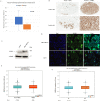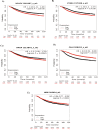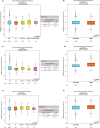Identification of novel interacts partners of ADAR1 enzyme mediating the oncogenic process in aggressive breast cancer
- PMID: 37221310
- PMCID: PMC10206070
- DOI: 10.1038/s41598-023-35517-6
Identification of novel interacts partners of ADAR1 enzyme mediating the oncogenic process in aggressive breast cancer
Abstract
Triple-negative breast cancer (TNBC) subtype is characterized by aggressive clinical behavior and poor prognosis patient outcomes. Here, we show that ADAR1 is more abundantly expressed in infiltrating breast cancer (BC) tumors than in benign tumors. Further, ADAR1 protein expression is higher in aggressive BC cells (MDA-MB-231). Moreover, we identify a novel interacting partners proteins list with ADAR1 in MDA-MB-231, using immunoprecipitation assay and mass spectrometry. Using iLoop, a protein-protein interaction prediction server based on structural features, five proteins with high iloop scores were discovered: Histone H2A.V, Kynureninase (KYNU), 40S ribosomal protein SA, Complement C4-A, and Nebulin (ranged between 0.6 and 0.8). In silico analysis showed that invasive ductal carcinomas had the highest level of KYNU gene expression than the other classifications (p < 0.0001). Moreover, KYNU mRNA expression was shown to be considerably higher in TNBC patients (p < 0.0001) and associated with poor patient outcomes with a high-risk value. Importantly, we found an interaction between ADAR1 and KYNU in the more aggressive BC cells. Altogether, these results propose a new ADAR-KYNU interaction as potential therapeutic targeted therapy in aggressive BC.
© 2023. The Author(s).
Conflict of interest statement
The authors declare no competing interests.
Figures






Similar articles
-
Increase in ADAR1p110 activates the canonical Wnt signaling pathway associated with aggressive phenotype in triple negative breast cancer cells.Gene. 2022 Apr 20;819:146246. doi: 10.1016/j.gene.2022.146246. Epub 2022 Feb 2. Gene. 2022. PMID: 35122924
-
Evaluating the therapeutic potential of ADAR1 inhibition for triple-negative breast cancer.Oncogene. 2021 Jan;40(1):189-202. doi: 10.1038/s41388-020-01515-5. Epub 2020 Oct 27. Oncogene. 2021. PMID: 33110236 Free PMC article.
-
Transcriptome Profiling of ADAR1 Targets in Triple-Negative Breast Cancer Cells Reveals Mechanisms for Regulating Growth and Invasion.Mol Cancer Res. 2022 Jun 3;20(6):960-971. doi: 10.1158/1541-7786.MCR-21-0604. Mol Cancer Res. 2022. PMID: 35247916 Free PMC article.
-
An RNA editor, adenosine deaminase acting on double-stranded RNA (ADAR1).J Interferon Cytokine Res. 2014 Jun;34(6):437-46. doi: 10.1089/jir.2014.0001. J Interferon Cytokine Res. 2014. PMID: 24905200 Free PMC article. Review.
-
ADAR1 and its implications in cancer development and treatment.Trends Genet. 2022 Aug;38(8):821-830. doi: 10.1016/j.tig.2022.03.013. Epub 2022 Apr 19. Trends Genet. 2022. PMID: 35459560 Free PMC article. Review.
Cited by
-
Structural impacts of two disease-linked ADAR1 mutants: a molecular dynamics study.J Comput Aided Mol Des. 2024 Jul 17;38(1):25. doi: 10.1007/s10822-024-00565-1. J Comput Aided Mol Des. 2024. PMID: 39014124
-
ADAR1-mediated RNA editing in breast cancer: molecular mechanisms and therapeutic implications.Med Oncol. 2025 Aug 9;42(9):421. doi: 10.1007/s12032-025-02979-9. Med Oncol. 2025. PMID: 40782195 Review.
-
Deciphering the mechanistic roles of ADARs in cancer pathogenesis, tumor immune evasion, and drug resistance.Front Immunol. 2025 Aug 7;16:1621585. doi: 10.3389/fimmu.2025.1621585. eCollection 2025. Front Immunol. 2025. PMID: 40852728 Free PMC article. Review.
References
Publication types
MeSH terms
Substances
LinkOut - more resources
Full Text Sources
Miscellaneous

